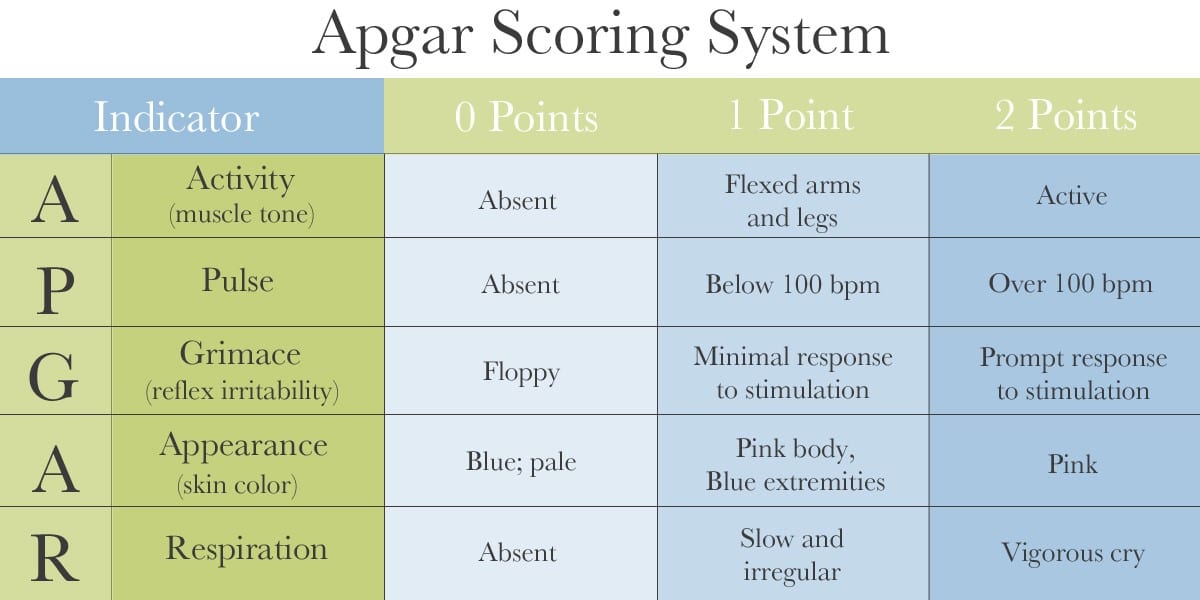The Apgar score is a simple diagnostic process used to quickly assess a newborn baby’s general health immediately following birth. The Apgar score was created in 1952 by an anesthesiologist named Virginia Apgar. Since its creation, the test has been used to determine a newborn’s health and stability right after delivery in the birthing room. It measures a baby’s health on five simple criteria, which include the following:
- Appearance / Complexion
- Pulse rate
- Grimace (reflex irritability, which measures the baby’s reaction when he or she is stimulated)
- Activity (muscle tone)
- Respiratory effort (breathing)
Each criterion is measured on a scale from zero to two, with two being the healthiest score and zero the unhealthiest. The five values are then added up to make a score from 0 to 10.
What Do Low Apgar Scores Indicate?
 The Apgar test is usually given to a baby twice: once at 1 minute after birth and again at 5 minutes after birth. A baby who scores a 7 or above on the test at 1 minute after birth is generally considered in good health. A score between 4 and 6 could mean that the baby needs some help breathing or is in trouble. A score of 3 or less may mean that the baby needs more immediate lifesaving measures such as resuscitation. At 5 minutes after birth, the Apgar score is recalculated. If the baby’s score hasn’t improved to 7 or greater, the doctor and nurses will continue medical care and closely monitor the baby.
The Apgar test is usually given to a baby twice: once at 1 minute after birth and again at 5 minutes after birth. A baby who scores a 7 or above on the test at 1 minute after birth is generally considered in good health. A score between 4 and 6 could mean that the baby needs some help breathing or is in trouble. A score of 3 or less may mean that the baby needs more immediate lifesaving measures such as resuscitation. At 5 minutes after birth, the Apgar score is recalculated. If the baby’s score hasn’t improved to 7 or greater, the doctor and nurses will continue medical care and closely monitor the baby.
Tell us your story.
Dealing with a birth injury diagnosis can be difficult, but our attorneys can help. The ABC Law Centers: Birth Injury Lawyers team focuses exclusively on birth injury and are dedicated to earning justice for families like yours.
Low Apgar Scores and Cerebral Palsy
A low Apgar score may be normal for some newborns, particularly babies who are born prematurely. Sometimes perfectly healthy babies have a lower than normal score. However, a study published in the British Medical Journal, researchers in Norway concluded that a low Apgar score in children born at term or with a normal birth weight is strongly associated with birth trauma and cerebral palsy (CP) in childhood.
The researchers used data from the Medical Birth Registry of Norway and the Norwegian Registry of Cerebral Palsy in Children to assess the association of an Apgar scores five minutes after birth with CP in 543,064 children born between 1986 and 1995. A prevalence of cerebral palsy in children with an Apgar score of less than 2 was more than 100 times higher than in children with a score of 10.
A low Apgar score was also associated with several types of spastic cerebral palsy, including:
- Spastic diplegia
- Hemiplegia
- Quadriplegia
Should I contact an attorney?
Did your child have low apgar scores at birth and was later diagnosed with cerebral palsy? Your child’s injuries may have been the result of medical malpractice or negligence at birth. We can help! ABC Law Centers: Birth Injury Lawyers has focused exclusively on birth injury-related legal matters since 1997.
Free Case Review | Available 24/7 | No Fee Until We Win
Phone (toll-free): 888-419-2229
Press the Live Chat button on your browser
Complete Our Online Contact Form
